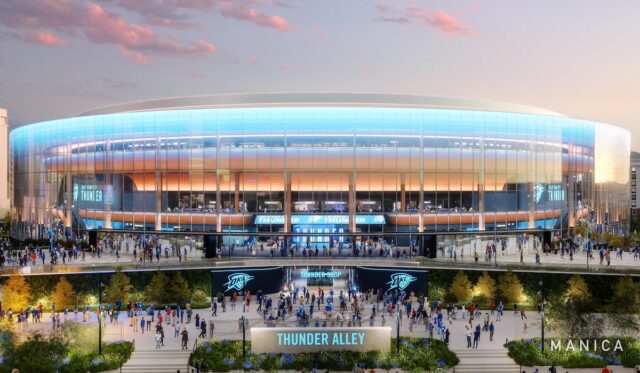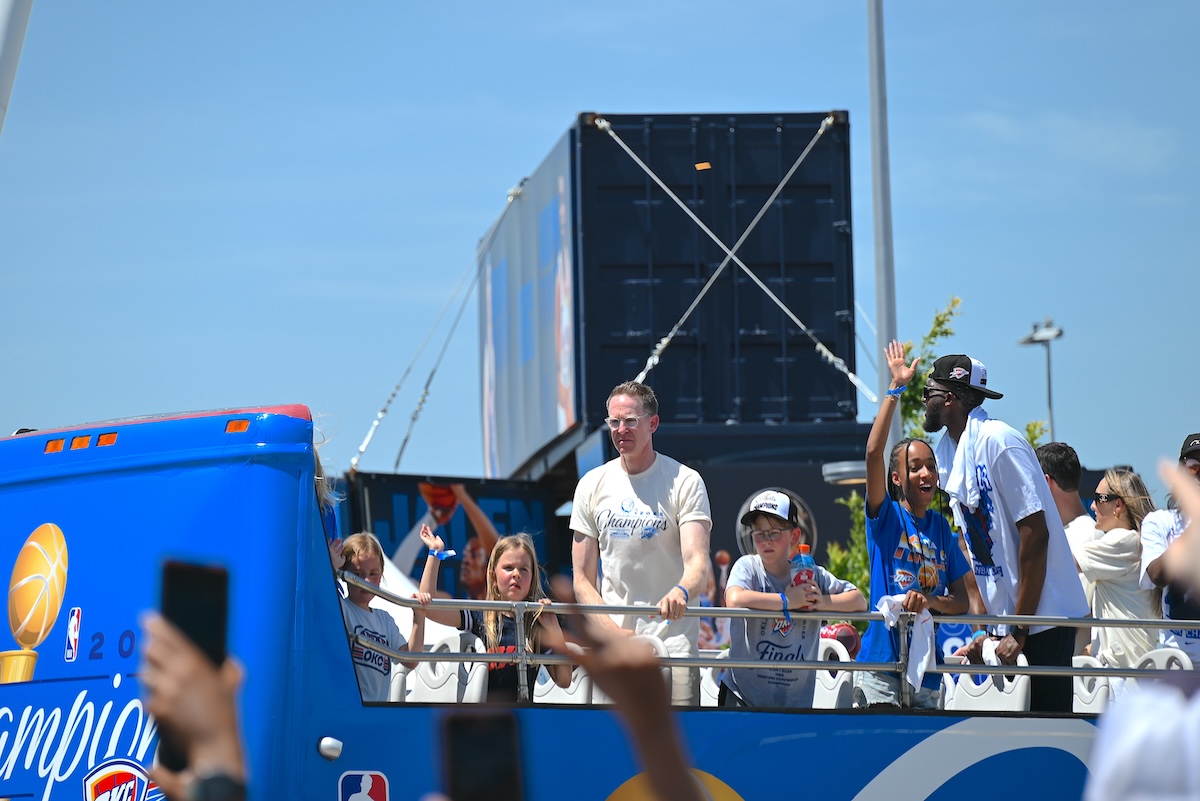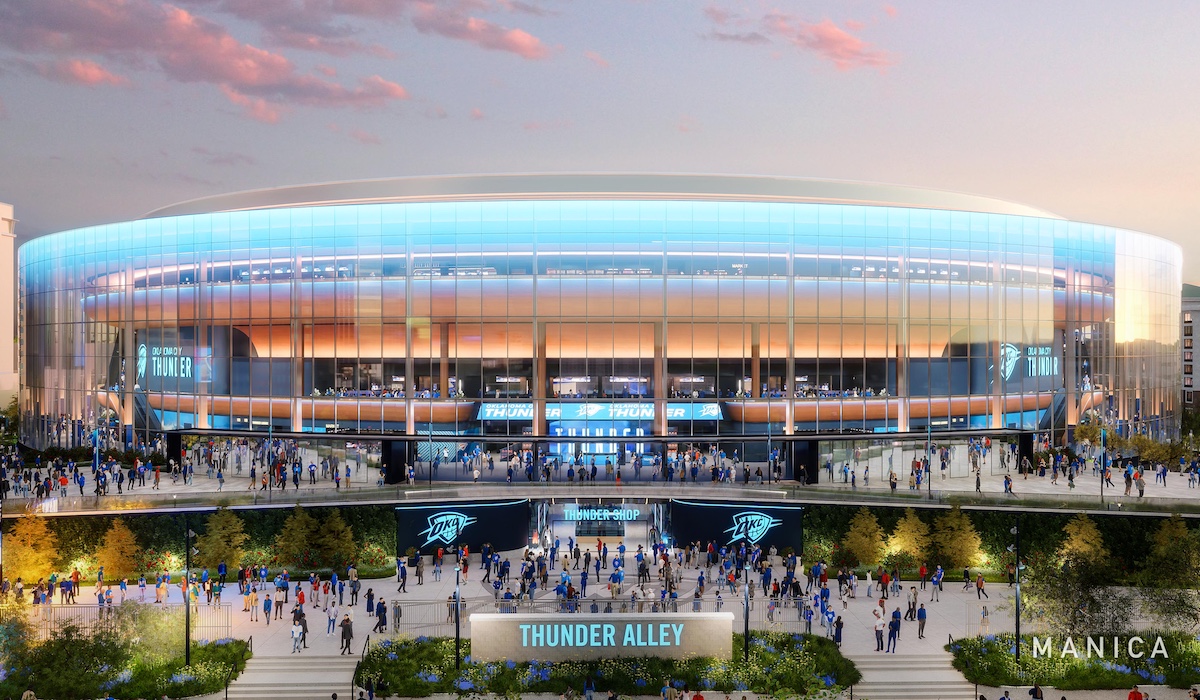 A rendering shows the new Oklahoma City arena that features an anticipated 2028 opening date. (Manica Architecture)
A rendering shows the new Oklahoma City arena that features an anticipated 2028 opening date. (Manica Architecture)
Support Journalism
Mayor David Holt spent much of this year’s State of the City address noting progress the city has made when it comes to things like housing its homeless population, improving its streets and developing its upcoming bond package. Still, Wednesday’s event offered the first glimpse of the city’s new publicly funded basketball arena — an unveiling that drew a standing ovation at the OKC Convention Center.
The mayor’s annual address, presented by the OKC Chamber of Commerce, is part pep rally and part discussion of where the city stands at a given point in time. But this one was different. It comes on the heels of the city’s first NBA championship, won last month, and the massive celebration held just days later.
“We did it, OKC,” Holt told the packed convention center meeting room. “We did it.”
But Holt also said more must be done and there is no time to rest.
“In its modern history, Oklahoma City has always asked itself what is next,” Holt said. “And so today, even as the sun hits our face a little different than it did before, we shall ask that question once again.”
What’s next includes a $2.7 billion bond package that will go before voters Oct. 14. The 11-proposition, 547-project package entails a wide array of priorities — from street improvements to housing initiatives to a new crime lab for the OKC Police Department.
And work is also beginning on the project that saw its design unveiled Wednesday: the nearly $1 billion new arena that will serve as home for the OKC Thunder and, with any luck, an expanded concert lineup. The Thunder’s ownership has pledged to contribute $50 million toward the project’s construction, and the rest will be paid for by a one-cent sales tax overwhelmingly approved by voters in 2023.
As depicted in a video that includes the phrase “roaring like a river of Thunder,” the new arena will feature a circular design and a glass perimeter, creating sweeping views of downtown, the Myriad Gardens and the setting sun. Holt and architect David Manica said the new arena’s seating capacity is yet to be determined but will be similar in size to arenas constructed over the past decade, which Holt said have been smaller than those of the current Paycom Center’s generation.
Concert lineup could be upgraded with new arena logistics
Wednesday’s State of the City presentation included renderings and the video of the new arena, which brought applause from the audience. The arena will also include wraparound concourses that are shared by fans, and Manica said its design will also be more concert-friendly. The Paycom Center has reportedly missed out on some shows because of its reputation for being hard to load equipment into and out of, owing to the position of its loading dock. The new arena won’t have that problem, Manica promised.
“The ability for a building to host a successful concert is dependent upon a lot of different physical things,” Manica said. “Its rigging capacity, its comfort of the back of house areas, its ability to load in and load out quickly. When a building gets a disfavorable reputation in the industry for being a difficult building to load, it drops off the list of tour sites. Now you guys are right in the middle of all those buses going back and forth across the country. This building, with its sort of updates, will put it in the market for all those shows in a way that your existing building doesn’t really afford you to have, just because it is of a previous generation of building.”
RELATED

Searching for Scissortail Park: Hot times and high security at the Thunder parade by Andrea Hancock
The arena will be vastly more expensive and larger than the current Paycom Center, which was built for about $90 million more than two decades ago. But large capital projects can become cash sinkholes because of cost overruns and inflation. Oklahoma County has found that out the hard way with its ongoing funding saga for the new jail.
Asked if the arena risks similar cost overruns that could surpass its nearly $1 billion projected price tag, Holt bristled slightly at the question during a press conference following his speech.
“It’s obviously not going to cost over $1 billion,” Holt said. “This is within budget. I made that point out there. You know, that’s why we brought in construction managers. That’s really novel, compared to previous public projects, that we have them at the table. And that allows us to have a lot more confidence. They do this for a living. I don’t know if you have a background in construction, but we have people who are professionals who have certainly priced everything that you saw today and feel very comfortable that it’s within our budget. Obviously, we can’t control some things, right? But as far as today’s environment, we feel very confident in that.”
City Manager Craig Freeman said the design process will conclude with a final plan brought before the OKC City Council for approval. Located at the site of the now-demolished Cox Convention Center, the new arena is proposed to be ready by the summer of 2028.
“The designs are moving forward,” Freeman said. “We’ll bring those designs to the council, but we don’t know when. We don’t have the exact timing on that.”
Ward 4 Councilman Todd Stone said the new arena appears like it will be what he had hoped it would be.
“I’m excited about it,” he said. “To me, it sort of looks like an Oklahoma City cloud. It looks different from other arenas we’ve seen.”
Stone, who has a background in construction, said having construction managers participate in the design process should help the project stay within budget.
“We’ll have to work through it,” he said. “I think the city did a good job bringing in some construction people at the same time the design process is ongoing. That way we can sit there and look at the cost while the design process is ongoing, and I think that’s going to help make sure that we hit our budget.”
Ward 5 Councilman Matt Hinkle said he had previously met with Manica and had seen early designs of the project, which he praised.
“He sat and visited with us as a group for quite a while,” Hinkle said. “A lot of what he said is what all architects say, but at the end he came through. I think it’s beautiful. I think it’s going to fit well in the space. I hope it’s not value engineered. We’ll see in four or five years, but I think it’s going to be a great piece for this part of the city. I’ve been to a lot of NBA arenas, and it doesn’t look anything like the ones I’ve seen.”
Wednesday’s design announcement comes on the heels of the OKC City Council approving management contracts last month that include a labor agreement regarding pay and working conditions, which narrowly survived a motion from Ward 1 Councilman Bradley Carter to remove it from the full agreement.
$2.7 billion bond package set for Oct. 14 vote
 Members of the public meet City of OKC staff at an open house Tuesday, Nov. 12, 2024, at the Pete White Wellness Center in southwest Oklahoma City for the next round of GO bonds expected to be proposed and voted on in 2025. (Matt Patterson)
Members of the public meet City of OKC staff at an open house Tuesday, Nov. 12, 2024, at the Pete White Wellness Center in southwest Oklahoma City for the next round of GO bonds expected to be proposed and voted on in 2025. (Matt Patterson)
Long before the first jump shot graces the nets of the new arena, OKC voters will determine the fate of a $2.7 billion bond package that will go before them Oct. 14. Among its components is a whopping $1.3 billion for streets that will include 133 residential resurfacing projects, 27 street widening projects, 25 sidewalk projects and 184 arterial resurfacing projects.
Additionally, another $414 million would be directed toward parks and recreational facilities. That includes renovations to parks, park facilities and trails. It will also include expansions or renovations of the Lake Hefner golf clubhouse, Chickasaw Bricktown Ballpark, Bricktown Canal, Civic Center Music Hall and USA Softball Complex, as well as the Riversport Rapids and Regatta Park facilities, among others.
About $175 million would be directed to citywide economic development and affordable housing programs, while another $140 million would be used for 44 drainage improvement projects around the city.
Another proposition would fund a new training center for the city’s fire and police departments, as well as a new maintenance facility to be located at Southwest 15th Street and South Portland Avenue. Several fire stations would also be expanded and upgraded.
The package would also include about $130 million for transit, including a new headquarters facility, downtown parking garage and modernization of EMBARK’s fleet of buses. The police department would see a new crime lab, a new police station in west OKC and a new parking garage for police, courts and 911 operations.
About $90 million would be used to fund 25 bridge projects and reduce or mitigate flood risks. Another $81 million would be used for 25 intersection improvements, including new traffic signals and other upgrades. About $52 million would be allocated for the city’s libraries and would provide upgrades to the Ron Norick Library downtown and an expansion of the Ralph Ellison Library on the city’s east side.
“This new bond issue puts $2.7 billion towards core infrastructure across the city,” Holt said Wednesday. “And it does so without increasing property taxes, as we simply extend the taxation that has expired from previous bond issues. Most of what you pay in property taxes each year does not go to the city government. We are just a small slice of your overall property tax bill. And the average millage rate you’re paying today in those property taxes to the city will stay the same over the next decade as this bond issue plays out. And if it stays the same, you’ll get to keep driving on streets and drinking water. This is not an initiative for dreamers. It’s about maintaining what we have. It’s about the basics. It’s about needs, not wants.”
Stone said he was pleased with the final bond package, which came largely from public input over the last year.
“The majority of the money is going to fix our streets and things like that, which we need,” he said. “Every specific ward wants more of it but overall, I’m generally pleased with how they laid it all out. I think there’s something for everyone in it.”
Hinkle said he believes the city’s south side, home to his ward, will receive some critically needed street improvements.
“I’m not crazy about the way it was divided up per ward, but the south side of OKC got more than its fair share,” he said. “Ward 5 is a tiny little spot. [Ward 3 and Ward 4] are all across Oklahoma City. But we’re getting lots of new roads and lots of new infrastructure down there, which is sorely needed. It hits a lot of different areas. Some of it isn’t as much infrastructure as I would want it to be, but that’s OK. I get it. There is a lot of the city that I don’t have say over and don’t understand how it works. I don’t want to be telling a chef how to bake a cake when I don’t know how to do it myself.”
![]()
Support Journalism

